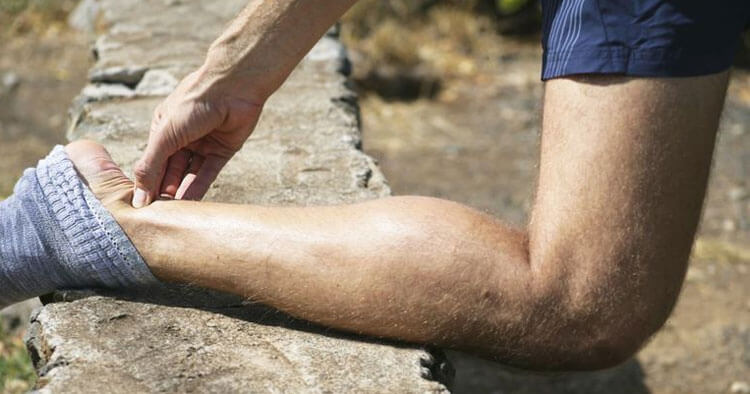Muscle Pain and Tendinopathy, Sports Injuries and Management
Achilles Tendinosis As A Cause Of Achilles Tendon Pain
Achilles Tendinosis And Other Causes Of Achilles Pain
There are a number of pathologies associated with Achilles tendon pain, one of which Achilles tendinosis. Tendinosis indicates degenerative change is present where as Achilles tendonitis indicates inflammation is present and Achilles tendinopathy considered the preferred term by many, indicates the possibility of inflammation, degeneration and/or tendon tears being present. Other common causes of pain in the region of the Achilles tendon can include peritendinitis and retrocalcaneal bursitis, these respectively indicate the presence of painful inflammation of the sheath surrounding the Achilles tendon, or inflammation of the fluid sac at the insertion of the Achilles tendon into the heel bone.
Achilles Tendon Rupture
A devastating cause of Achilles tendon pain is an Achilles tendon rupture. Achilles tendon rupture is a complete tear of the Achilles tendon, this type of injury is generally the result of a sudden acceleration when running, such as pushing off to sprint or jump in tennis, netball, or football codes. Regarding the Achilles tendon ruptures that I see treat in my Sydney physio practice they are mostly presenting in middle-aged people participating in sports in their spare time. However having said that in recent months I have seen a few Achilles ruptures in younger social athletes all aged under 30 years old. The contributing factor considered here was considered to be the extended break from their sports as a result of covid-19 shutting down community sports for an extended period, and then returning to playing without having any “preseason” of note.
With an Achilles tendon rupture the individual may hear a “snap: or “pop” noise when the tendon ruptures associated with pain and an immediate loss of power in pushing off actions. Frequently there is also a fairly rapid onset of swelling around the point of rupture. Achilles rupture requires immobilisation and orthopaedic assessment, this is all done sooner rather than later to assess the relevance of any surgical intervention. Rupture of the Achilles tendon in Sydney is frequently managed via surgical intervention, a surgical repair of the tendon followed with an extended period of immobilisation in a boot, progressing into extended physiotherapy rehabilitation program guided by the surgeons protocol.
Symptoms Of Achilles Tendinopathy
Pain is the most obvious and common symptom associated with Achilles tendinosis and tendinopathy. The pain is often felt first thing in the morning, or when moving after a period of inactivity and is usually associated with actions stretching the tendon, or loading it like walking, running…
Some People Also Experience:
- Stiffness In The Tendon: This sensation of stiffness is frequently experienced first thing in the morning, or at the beginning of exercise. This stiffness may well lesson throughout activity, only to return, or even worsen again once cooled down following activity.
- Swelling: The Achilles area may be swollen, red and warm on palpation if there is inflammation present.
- Tenderness on palpation: This may be anything from mild to severe pain and tenderness when the area is touched, or knocked. In some cases there may also be a palpable thickening around the site of pain.
- Reduced strength: A perceived loss of strength and power may exist, with a feeling of sluggishness in the leg sometimes reported with Achilles tendinopathy.
Achilles tendinopathy can be graded according to severity. The following is a grading is a guide only, where Grade 1 is more mild pathology and Grade 4 is considered as severe symptoms.
- Grade 1 – The individual experiences pain after running/activity only.
- Grade 2 – The individual experiences pain before and after running/activity, yet the pain lessons during the run (sport).
- Grade 3 – The individual experiences pain with activity, significant enough to cause them to ultimately begin to decrease their volume of activity.
- Grade 4 – The individual experiences pain during everyday activities, not just associated with running, or sports.
Diagnosing Achilles Tendinosis
Getting an understanding of the history and behaviour of any Achilles pain is key to assisting in making a diagnosis. Coupling this information with a physical examination of the area your physiotherapist will be able to get a good understanding of the condition. In some situations referral for ultrasound and/or MRI imaging is useful for gauging the true extent of any degeneration, tears, and inflammation present, or the presence of any peritendinitis, or retrocalcaneal bursitis which could be contributing to the Achilles tendon pain.
Disclaimer: Sydney Physio Clinic provides this information as an educational service and is not intended to serve as medical advice. Anyone seeking specific advice or assistance on Achilles Tendinosis A Common Cause Of Achilles Tendon Pain should consult his or her physiotherapist, sports medicine specialist, orthopedic surgeon or otherwise appropriately skilled practitioner.


